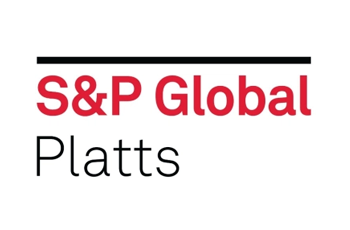Production Increasing Despite Capital Discipline
U.S. shale crude and condensate production grew by 3% in 1Q18, a relatively small quarter-over-quarter increase driven by winter weather events and slower completion activity. Production averaged 5,430 MB/D for the quarter, led by the Permian with 2,240 MB/D. However, we forecast strong 2018 growth of + 1,140 MB/D year-over-year, averaging 5,820 MB/D during the year.
 Propane Prices Gain and Strengthen Relative to Crude Prices
Propane Prices Gain and Strengthen Relative to Crude Prices
Front-month non-LST propane gained 6.3% week-on-week and closed the week at 94.6 cents/gal. US Gulf Coast propane prices continue to strengthen with strong exports coupled with three straight weeks of inventory builds. The non-LST propane price ended the week at 56% of the front-month crude price. With forward curves at Conway and Mont Belvieu starting to flatten out from the steep backwardation recently, markets may start to shift volume to storage and away from exports. US inventories built by 1.69 million barrels during the week ended May 11, according to EIA data. Exports last week were reported at 766,000 b/d, compared with Platts Analytics’ estimate of 1.07 million b/d based on cFlow data. For the week ending May 18, exports are expected to be 950,000 b/d on steady VLGC activity at Texas terminals. Steam cracker feedstock margins remain weak.
India’s New National Biofuels Policy Will Stimulate Ethanol Use
India has had a 10% ethanol in gasoline mandate for over a decade, but it has never been enforced. Historically, all of India’s goals pertaining to biofuels have been aspirational. This week, India’s Union Cabinet, chaired by Prime Minister Narendra Modi, approved the country’s latest biofuels policy. Until now, only ethanol from molasses and biodiesel made from non-edible oil seeds could be blended into transportation fuels. The new policy allows the use of feedstocks such as sugar juice, sugar beets, corn, cassava, wheat, and municipal solid waste (MSW) and encourages the development of more advanced fuels such as bio-CNG.
The curve rallies on the wider commodity complex, as fundamentals take a back seat
Prompt prices have only gone in one direction since the beginning of summer, and this year it’s not down. This week marks a 7th set of consecutive prompt gains, with the curve sporting an even longer rally, starting back in mid-February. The initial upswing was clearly supported by fundamentals, as an exceptionally cold end to winter and a number of domestic European supply issues saw storage stocks drawdown to record lows. The dynamics of recent drivers, however, have been less clear.
Generally speaking, a rising wider commodity complex has added fuel to the fundamentally sparked fire. The latter interaction is at least in part justified, but with gas prices continuing to move in tandem with oil and coal, now the question is how long it can last.
Trade War: Cancelled!?
Depending on who you listened to during the Sunday morning talk shows, the trade war with China has either been cancelled, postponed, or seen no real change. Treasury Secretary Mnuchin used the term “trade war on hold”. Economic Advisor Kudlow said things like “good progress”, but also conceded “there’s a framework, but no deal”. Trade Representative Lightizer was much more hawkish with his “tariffs remain an important tool” statement. So, which one is it? The soybean and corn markets appear to be siding with Mnuchin, although the time for a victory lap may be early as the devil is always in the details with these sorts of matters and cutting $200 billion out of a trade deficit, Trump’s apparent goal, would be no small feat. Besides, even if there is a truce on the horizon, would a calming of tensions result in more soybean supplies coming off the global balance sheet? Probably not.
U.S. Commercial Stocks Show Small Decline
Overall commercial oil inventories were roughly flat the week ending May 11 compared to a build last year, widening the year-on-year stock deficit by around 5 million barrels. The standout was gasoline which showed a 3.8 million barrel stock decline, 1.7 million barrels of which was in the Central Atlantic region, taking overall stocks 8.7 million barrels (3.6%) below last year with the Central Atlantic region 6.3 million barrels (16.4%) under last year. Even though distillate inventories were unchanged, Central Atlantic stocks drew another 1.1 million barrels this past week to the lowest weekly level since 2003 for this particular week. Looking to this week, each of the three major light products show stock declines as demand improves. Crude stocks decline slightly with the entire decrease in Cushing, where inventories are forecast to begin showing declines, falling 0.80 million barrels next week.
 US Gas Weekly Report
US Gas Weekly Report
The June NYMEX Henry Hub futures contract traded between $2.79/MMBtu and $2.86/MMBtu last week, settling at the high end of the range on Thursday — despite the first triple-digit injection of the season per the EIA storage report. Thursday’s settlement price marked a two month high for the contract. Moreover, the June contract also cleared its respective 200-day moving average, which had been a strong level of resistance. For prices to truly break out of the recent trading range, the market will need to close above ~$2.88/MMBtu — which coincides with the NYMEX nearby continuous chart 200-day moving average. Given upside risks to power burns this summer, S&P Global Platts Analytics continues to see upside risks to summer NYMEX prices.
China and U.S. Expand Solidly, Despite Headwinds
China’s April economic data releases highlighted two major ongoing developments. The first is the government’s policy stance on credit deleveraging and economic rebalancing, and the second is a better-than-expected recent performance by the country’s industrial sector. The net effect on economic growth from these developments was probably about neutral. In the U.S., consumer spending is on the path for a solid rebound, after experiencing sluggish growth in the early part of the year. While higher energy prices will be a headwind for the consumer sector, U.S. households are expected to be able to withstand this challenge.
Tanker Earnings Being Squeezed By Weak Rates and Rising Bunker Prices
Tanker earnings have been squeezed by rising bunker prices and weak rates to levels well below cash-breakeven. Bunker prices have been rising rapidly along with the flat price of crude oil and owners have been unable to pass the added costs to shippers due to an oversupplied tanker market. There is little relief in sight.
OPEC Supply Losses Mounting
Geopolitical events in the first half of May are already supportive of oil prices, even though most of the impact on physical balances will not be felt until the weeks and months ahead. Most notably, U.S. sanctions are set to cut Iranian crude exports by ~200 MB/D by November, with even greater losses set for 2019. Venezuelan crude production of 1.5 MMB/D is down 500 MB/D year-over-year and heading south. Its beleaguered oil industry is facing intense pressure from claims on PDVSA assets, in addition to the prospect of U.S. sanctions after the May 20 presidential election. Sabotage-related pipeline closures in Nigeria have cut collective Forcados and Bonny Light production by at least 150 MB/D, while a prolonged coalition-building process in Iraq will likely delay the return of 280 MB/D of northern exports. Collectively, these factors will cause a downward revision to our supply forecast. Our end-April Reference Case forecasts OPEC crude production to grow by 110 MB/D between 2Q18 and 4Q18, mostly on higher production in Iraq and new field startups in West Africa. But given recent events, a decline over this period now looks more likely. Rising political risks are especially bullish in the current market environment, as they come at a time of increasingly tight fundamentals.
High Capture Prices of German Wind and Solar Trending Lower
While a buoyant fuel pricing complex is further squeezing thermal asset margins, renewable capacity across Europe continues to grow to the point that wind is now approaching gas as the largest generating technology. As known, solar growth has recently slowed down, with Europe no longer among the top installers of solar globally, but total installed capacity has nevertheless now reached an important milestone, having moved closer to nuclear. Given the already large renewable capacity in the system and the increased reliance of new projects on market prices, it’s interesting to look at the capture prices of solar and wind, defined as the hourly prices when solar and wind plants are generating. Recent data shows that, in both cases, capture prices of renewables across Europe are rather high regardless of the season.
Oil Implications of a Potential North Korean Peace Dividend
Recent peace dividend examples in the area (e.g. Myanmar, Vietnam, Cambodia, Laos) suggest North Korea might be able to achieve much faster economic growth and development if certain things fall into place, but it starts from a very low base. Oil demand could easily increase by up to ten-fold by 2030, rising to about 200 MB/D. Barrel growth will initially be concentrated in gasoil / diesel and LPG, driven by industrialization. “Cheap” high sulphur fuel oil, as a by-product of IMO 2020, could find a ready consumptive sink. North Korea will remain dominated by coal consumption, with revitalization of underutilized hydro capacity also likely. Port facility development is a significant growth opportunity to support increased trade. China, South Korea, and Japan are best positioned geographically and economically to meet rising demands.
Global Equities Ease on Weakness in Emerging Markets
Global equities eased with apparent weakness in emerging markets. The U.S. tracking index only lost about 0.5%, with retail, energy and materials all posting solid gains, while utilities lagged and lost 2.8%. Internationally, world, ex-US, was lower by -1.1%, while emerging markets fell -2.8%, with Latin America being the weakest performer, down -5.3%. Spillover impacts from problems in Argentina are seen as the primary driver.
U.S. Ethanol Prices Fall
The week ending May 11 ethanol assessments dropped to the lowest level in eight days. Manufacturing margins improved as corn prices declined. Discounts for bending ethanol in gasoline were this highest in four years. The EPA sent the proposed mandates for biofuels for 2019 and bio-mass diesel to the OMB for review and approval. Hydrous ethanol in the South-Central region of Brazil soared.
By 2020, the Eastern Mediterranean Reaches Physical Constraints, Displacing Qatar Even Further
Gas balances in the South East corner of the Mediterranean continue to lengthen and the region will soon become a net exporter. Specifically, we are speaking of Israel, Egypt, and Jordan. While much of the discussion has been around the Zohr mega field impacting LNG, more is going on in this region that may set the stage for increasing pressure on LNG suppliers – in particular Qatar.
Release of “Official” EU ETS Oversupply Confirms 2019 Supply Cut
The European Commission on May 15th released their current estimate of the Total Number of Allowances in Circulation (TNAC) in the EU ETS, a number which will be used to determine the volume of auction allowances that will be placed in the Market Stability Reserve from January-August 2019. While their calculations may underestimate ETS demand through end-2017, the TNAC’s impact on withdrawals is in line with previous expectations (as well as estimates using the previously estimated TNAC). This TNAC implies that an annualized 397 MT will be removed from 2019 auction volumes, leaving ~550 MT to be auctioned. The EC release came after the close of trading on ICE, where EUAs finished the day at €14.32 (down €0.32 on the day). While the announced TNAC is directionally bullish for EUA prices as it indicates a declining cumulative market surplus, EUA prices this year have already reacted strongly to next year’s MSR-related supply cut (as well as continued support from TTF gas prices), potentially limiting a further upside response.
Tighter Fundamentals and Stronger Oil & Gas Prices Push Coal Higher
The global coal market continued to appreciate this week, with persisting physical tightness and strength in oil and gas markets providing the bullish momentum. As far as coal fundamentals go, recent developments have been decidedly bullish. On the demand side, India’s return to heavier thermal coal imports due to lackluster domestic supply, and the continuation of strong weather-related coal demand in China has the potential to keep the market tight over the short-term.
Canadian Pipeline Update: A lot of activity but little construction
Recent activity on moving forward with new pipeline capacity out of western Canada has been robust, but it has been primarily centered around political and regulatory actions rather than putting pipe in the ground. Recent actions include: the Administrative Law Judge (ALJ) presiding over the Minnesota PUC Line 3 replacement project putting forward a recommendation that is likely untenable to Enbridge, the federal government announcing that it is willing to indemnify Kinder Morgan from political risks to the Trans Mountain project, and the Alberta government passing legislation that would allow it to control the flow of crude and products from the province. By the end of June, further actions are expected, including a final Minnesota PUC decision on Line 3 replacement, a likely decision from the Federal Court of Appeal on challenges to the NEB’s approval of the Trans Mountain expansion, and B.C. Supreme Court decisions on challenges to B.C.’s environmental permits granted for the same project.
It's time to pay attention to power burn, not just Northeast production
Northeast production has received the bulk of the market's attention this summer, and rightfully so, with the possibility of a large production response this summer erasing the current US storage deficit. However, perhaps more notable, the market appears to be losing sight of the robust burns witnessed year-to-date and, in particular, month-to-date. In fact, Platts Analytics believes there is more than 1.2 Bcf/d of high side risk to its current balance of summer burn forecast, a risk that should it materialize, leave storage on pace for a 3.2 Tcf ending October inventory, a bullish sign for Henry Hub prices.
Nine Lives for the NOPR?
With the failure of Department of Energy's (DOE) 2017 notice of proposed rulemaking (NOPR) to support "fuel secure" generation, Trump administration policymakers have been exploring other avenues to support at risk coal and nuclear plants. Platts Analytics assesses the likelihood that policy will result from the DOE’s efforts, what authority the DOE may use, and how any policy might impact power, natural gas and coal markets.
Ethanol production increased as plants returned after spring maintenance
U.S. ethanol production rose for the third consecutive week, increasing by 18 MB/D to 1,058 MB/D. Output has grown around 73 MB/D since the peak of the spring maintenance period. Ethanol stocks declined for the second straight week, dropping by 459 thousand barrels to 21.5 million barrels. Inventories built in the Midwest for the first time since early March. Ethanol-blended gasoline output was up 184 MB/D to a 2018-high 9,328 MB/D.
Japan Lower Runs Should Begin to Tighten Balances
We are nearing a shift in the balances from lower runs. The seasonal gasoil build is largely complete and stocks should begin to trend lower, as should gasoline. On the week, crude stocks built slightly, as did finished product stocks. Major product demand should begin to start rising from seasonally low levels while refinery supply will tend to lessen. Refining margins remain weak, but should improve on tighter balances, while retail margins are having an increasingly difficult time passing through the higher purchase prices as oil prices have generally continued rising.
Credit Conditions Remain Constructive Amid Stronger Energy Prices
Credit conditions remain constructive, despite continuing issues in some key emerging markets. The S&P 500 eased 0.5% on the week, and VIX volatility gained slightly, but remains low and below 14. Oil (WTI) again hit another new cyclical high and its volatility also eased. High yield debt was little changed but emerging market debt remained under pressure. Commodities were modestly higher, and again led by energy gains. The St. Louis financial stress indicator settled lower on the week, with overall stress levels remaining low.
LCFS Prices Resume Upward March, Despite Policy Rollback
Tighter program balances have pushed California Low Carbon Fuel Standard (LCFS) prices up considerably in 2018, in spite of CARB's proposal to relax the near term reduction requirements. LCFS regulatory amendments are to be adopted this year. We expect larger annual bank draws going forward, and cumulative deficits are likely after 2020. Longer term, LCFS pricing will also depend on meeting goals for electric vehicles, which are largely incentivized by other policies. Federal complementary policies like the RFS and vehicle GHG standards (poised to be rolled back by the Trump Administration) also interact with the LCFS, with weaker standards raising LCFS compliance costs.
The information above is part of PIRA Energy Group's weekly Energy Market Recap - which alerts readers to PIRA’s current analysis of energy markets around the world as well as the key economic and political factors driving those markets. To read PIRA’s Market Recap first, subscribe to PIRA Perspectives here.
Click here for additional information on PIRA’s global energy commodity market research services.


